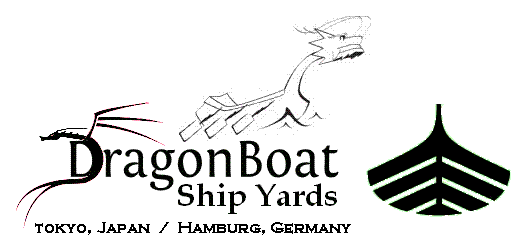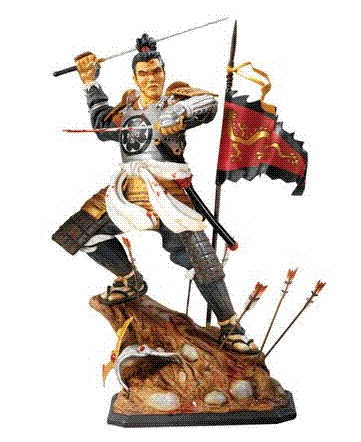
undefined
undefined

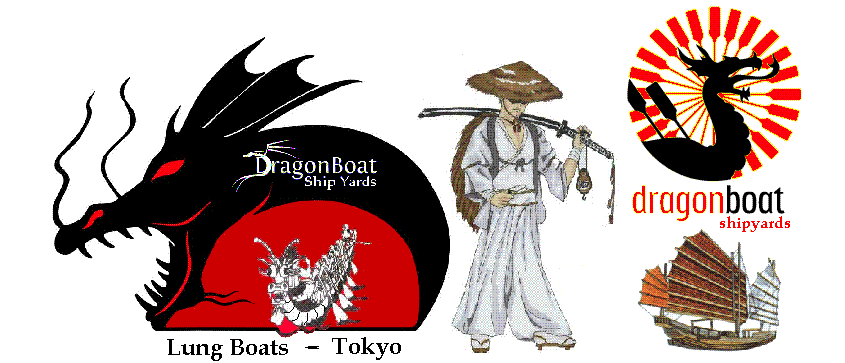
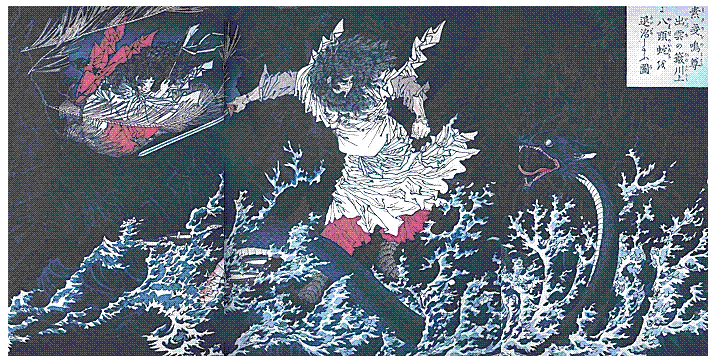
SUSANOO - God of Storm and Sea
==========================================================================
Susanowo (Susanoo) was the god of the sea and the storms according to the ancient Japanese religion of Shinto, which means "the way of the gods". He had a furious and impulsive temper. He could create ravaging storms that caused a lot of damage. Once, his sister, the Sun goddess Amaterasu, was so distressed by his fierce temper that she decided to hide herself in the cave of heaven.
Unfortunately, without Amaterasu, who ruled the realm of light, darkness surrounded the world. Evil spirits left their hiding places. Using a trick, the assembly of the gods got Amaterasu to come out of the cave. Light once again invaded and colored the world. To prevent another similar accident, the gods banished Susanowo in the province of Izumo and took away everything he had.
Thereafter, Susanowo had to overcome many dangerous adventures. Once he killed a monstrous serpent with eight heads and found the sacred sword, Kusanagi. After many adventurous journeys, Susanowo went to live with his mother Izanami in the underworld.
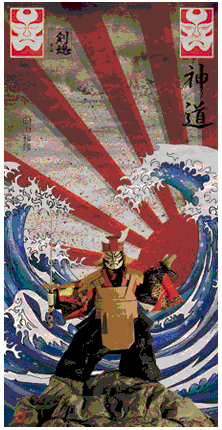
In Japanese mythology, Susanoo, the Shinto god of the sea and storms, is the brother of Amaterasu, the goddess of the sun, and of Tsukuyomi, the god of the moon. All three were spawned from Izanagi, when he washed his face clean of the pollutants of Yomi, the underworld. Amaterasu was born when Izanagi washed out his left eye, Tsukuyomi was born from the washing of the right eye, and Susanoo from the washing of the nose.
The oldest sources for Susanoo myths are the ca. 680 CE Kojiki and ca. 720 CE Nihongi. They tell of a long-standing rivalry between Susanoo and his sister Amaterasu.
Susanoo was punished by being banished from Heaven. He descended to the province of Izumo, where he encountered a grieving family of kunitsukami ("gods of the land") headed by Ashinazuchi in Izumo province. When Susanoo inquired of Ashinazuchi, he told him that his family was being ravaged by the fearsome Yamata-no-Orochi, an eight-headed serpent of Koshi, who had already consumed seven of the family's eight daughters and that it was nearing time for the creature to come for his final daughter, Kushinada-hime
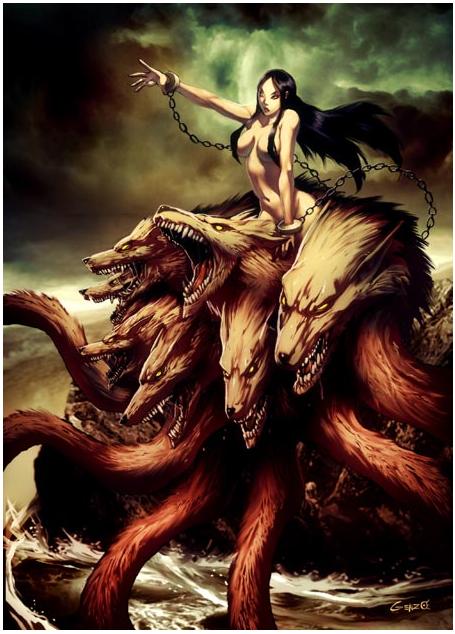
Susanoo investigated the creature, and after an abortive encounter he returned with a plan to defeat it. In return, he asked for Kushinada-hime's hand in marriage, which was agreed.

Susanoo attacked and slew the beast with his sword. He chopped off each head and then proceeded to the tails. In the fourth tail, he discovered a great sword hidden inside the body of the serpent which he called Ama-no-Murakumo-no-Tsurugi, and which he presented to the goddess, Amaterasu to settle an old grievance.
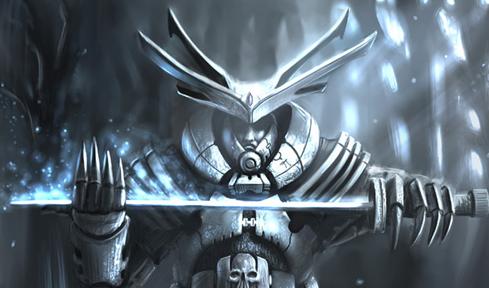
This sword from the dragon's tail, the Ama-no-Murakumo-no-Tsurugi ("Sword of the Gathering Clouds of Heaven") or the Kusanagi-no-Tsurugi ("Grasscutter Sword"), was presented by Susanoo to Amaterasu as a reconciliation gift. According to legends, she bequeathed it to her descendant Ninigi along with the Yata no Kagami mirror and Yasakani no Magatama jewel or orb. This sacred sword, mirror, and jewel collectively became the three Imperial Regalia of Japan.

Generations later, in the reign of the Twelfth Emperor, Keiko, the sword was given to the great warrior, Yamato Takeru as part of a pair of gifts given by his aunt, Yamato-hime the Shrine Maiden of Ise Shrine, to protect her nephew in times of peril.
These gifts came in handy when Yamato Takeru was lured onto an open grassland during a hunting expedition by a treacherous warlord. The lord had fiery arrows to ignite the grass and trap Yamato Takeru in the field so that he would burn to death. He also killed the warrior's horse to prevent his escape. Desperately, Yamato Takeru used the Ama-no-Murakumo-no-Tsurugi to cut back the grass and remove fuel from the fire, but in doing so, he discovered that the sword enabled him to control the wind and cause it to move in the direction of his swing. Taking advantage of this magic, Yamato Takeru used his other gift, fire strikers, to enlarge the fire in the direction of the lord and his men, and he used the winds controlled by the sword to sweep the blaze toward them. In triumph, Yamato Takeru renamed the sword Kusanagi-no-Tsurugi (lit. "Grasscutter Sword") to commemorate his narrow escape and victory. Eventually, Yamato Takeru married, ... and later fell in battle with a monster, after ignoring his wife's advice to take the Kusanagi-no-Tsurugi with him.
According to the Kojiki (Japan's oldest surviving book), Atsuta Shrine was originally founded around 100 AD after the site in Nagoya was chosen for the shrine to house the Kusanagi no Tsurugi.
Kusanagi-no-Tsurugi is a legendary Japanese sword as important to Japan's history as Excalibur is to Britain's, and is one of three Imperial Regalia of Japan. It was originally called Ama-no-Murakumo-no-Tsurugi "Sword of the Gathering Clouds of Heaven") but its name was later changed to the more popular Kusanagi-no-Tsurugi ("GrassCutter Sword").
Kusanagi is allegedly kept at Atsuta Shrine to this day, although it is not available for public display, and its existence cannot be confirmed. It is recorded that during the Edo period, a Shinto priest claimed to have seen the sword. According to him, the sword was about 84 cm long, shaped like calamus, fashioned in a white metallic color, and well maintained. Another record claims that this priest died from the curse and the power of the sword, but this is most likely a story that was spread to emphasize its power.
Atsuta Shrine is a Shinto shrine complex located in Atsuta-ku, Nagoya, Aichi Prefecture in Japan. Atsuta is known as the second-most venerable shrine in Japan (the first being the Ise Shrine). It reportedly houses the sword Kusanagi no Tsurugi, one of the Three Sacred Treasures of Japan, though it is never shown to the public. The shrine's Bunkaden, or treasure hall, houses over 4,000 relics, which include 174 Important Cultural Properties and a dagger that is a designated National Treasure of Japan.
In recent times, Japan's nationally run broadcasting station, NHK, went to Atsuta Shrine to videotape the sword but were turned away.
Due to the refusal of Shinto priests to show the sword, and the rather sketchy nature of its historical references, the current state of or even the existence at all of the sword as a historical artifact cannot be confirmed. The last appearance of the sword was in 1989 when Emperor Akihito ascended to the throne, the sword and regalia (including the jewel and the Emperor's two seals) were shrouded in packages.

=================================================================================
NB: The above text has been collected / excerpted / edited / mangled / tangled / re-compiled / etc ... from the following online sources :
SUSANOO - God of Storm and Sea - www.windows.ucar.edu
SUSANOO - God of Storm and Sea - wikipedia article #1
KUSANAGI - "GrassCutter Sword" - wikipedia article #2
SUSANOO - God of Storm and Sea - wikipedia article #3

